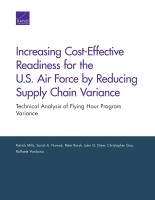| 来源类型 | Research Reports
|
| 规范类型 | 报告
|
| DOI | https://doi.org/10.7249/RR2118
|
| ISBN | 9780833098856
|
| 来源ID | RR-2118-AF
|
| Increasing Cost-Effective Readiness for the U.S. Air Force by Reducing Supply Chain Variance: Technical Analysis of Flying Hour Program Variance |
| Patrick Mills; Sarah A. Nowak; Peter Buryk; John G. Drew; Christopher Guo; Raffaele Vardavas
|
| 发表日期 | 2018
|
| 出版年 | 2018
|
| 页码 | 70
|
| 语种 | 英语
|
| 结论 |
Understanding the various sources of flying hour program (FHP) variance is key to crafting policy solutions to the causes.- Simple planning error is one source of uncertainty in predicting flying hours in a given year. Another is external causes, such as congressional action. A third source involves Air Force decisions made after the original flying hour program is set; this issue appears to be the most problematic and frustrating for supply chain managers. Examples of this are wide-scale flying hour cuts and combat aircraft reductions. Such changes in course are among the most disruptive examples identified and are sometimes large enough to register in enterprise-wide error metrics.
FHP variance causes negative, though usually modest, downstream effects on the supply chain.- Underflying, for example, can incur opportunity costs (leaving money on the table in the budget process). It can also incur financial costs (around $2–4 million annually in holding costs for unneeded inventory). Overflying, on the other hand, can contribute to readiness problems.
Some individual programs do experience large FHP variance and downstream effects.- Planners can be caught off guard when sudden, radical changes to a fleet's flying hour forecast appear, with little or no communication as to why, and with little opportunity to communicate the downstream effects, such as canceled contracts.
Improved flying hour planning would not significantly improve enterprise-level spare parts forecasting.- Flying hours are generally poor predictors of actual removals, and the Air Force bases its flying-driven parts forecasts primarily on that single variable. Better coordination and communication could help avoid many of the program-level perturbations experienced recently, but further efforts to reduce FHP variance may not have an observable effect on enterprise-level forecast accuracy because of the inherent underlying uncertainty.
|
| 摘要 |
- Already-implemented (essentially zero-cost) changes to the flying hour program planning process should be maintained. Such changes would mostly address simple planning error.
- Efforts to support, extend, and improve integration and communication should be continued. Improved communication and integration should help avoid surprises and also potentially mitigate shortsighted decisions.
- Management mechanisms that could dampen the downstream volatility caused by flying hour program variance should be considered. Managers could incorporate uncertainty into their decisions. If personnel upstream and downstream communicate clearly and regularly, they should be able to, collectively, reach decisions that are least cost to the Air Force.
- A holistic approach to improving spare parts forecasts should be continued. If the Air Force can improve its spare parts forecasting using information system solutions, this might allow managers to better calibrate spare parts decisionmaking, thus realizing benefits to readiness and cost-effectiveness.
|
| 主题 | Maintenance
; Repair
; and Overhaul
; Military Aircraft
; Military Budgets and Defense Spending
; Supply Chain Management
; United States Air Force
|
| URL | https://www.rand.org/pubs/research_reports/RR2118.html
|
| 来源智库 | RAND Corporation (United States)
|
| 引用统计 |
|
| 资源类型 | 智库出版物
|
| 条目标识符 | http://119.78.100.153/handle/2XGU8XDN/108747
|
推荐引用方式
GB/T 7714 |
Patrick Mills,Sarah A. Nowak,Peter Buryk,et al. Increasing Cost-Effective Readiness for the U.S. Air Force by Reducing Supply Chain Variance: Technical Analysis of Flying Hour Program Variance. 2018.
|
|
文件名:
|
x1523370929656.jpg
|
|
格式:
|
JPEG
|

|
文件名:
|
RAND_RR2118.pdf
|
|
格式:
|
Adobe PDF
|
除非特别说明,本系统中所有内容都受版权保护,并保留所有权利。